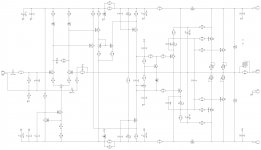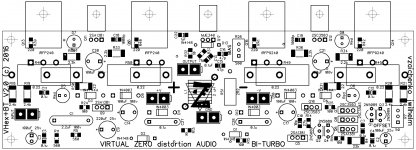Valery you can't stop,how many sons!🙂
Heat shink is one of more expensive part🙁
Right... In fact, even very good amplifiers modules, based on excellent topology, don't guarantee a good build. Heavy metal parts - heatsinks, transformers, cap banks, beefy quality wiring are vitally important for high-quality build, forming a significant portion of overall cost 🙁
It looks like 10" of Heatsink USA's 10.080 profile should work nicely as a plate amp.
10.080" Wide Extruded Aluminum Heatsink - HeatsinkUSA
That would be ample. By my reckoning 6" of that extrusion is about 0.3W/C so 10" will give you a healthy margin.
I need to machine a bit of the fins off for a crossover and mains inlet, so it won't be a full 10", but still likely larger than required, considering I didn't really warm up the scrap of C Channel I did my initial testing on.
I'll be interested to see how you get on with your testing, because if a single pair of these devices can work well at high output, it will certainly simplify the design of high power amplifiers.
I'll be interested to see how you get on with your testing, because if a single pair of these devices can work well at high output, it will certainly simplify the design of high power amplifiers.
Yes, if we can arrange a decent dissipation, the compact thing becomes rather universal in terms of scalability - on one hand, it can run at rather high rails (e.g. 90V), on the other hand, at lower rails it can handle low impedance loads (4 ohm, 2 ohm) - current supply capability is enormous. Bridged arrangements also look good in this case. Monoblock with two modules will be a hell of an amplifier (and welding machine at the same time 😛).
Right... In fact, even very good amplifiers modules, based on excellent topology, don't guarantee a good build. Heavy metal parts - heatsinks, transformers, cap banks, beefy quality wiring are vitally important for high-quality build, forming a significant portion of overall cost 🙁

Cheap EI transformers sometime cause sibilance or distortion in high frequency. Capacitance Multiplier improve the quality of mid and high frequency in class A and AB amplifier.
Vzaichenko, I think you should design a high quality power supply for your amplifiers 😉
Member
Joined 2009
Paid Member
Jef, I enjoyed the Strawberry pie at the end of May this year in your town - about 20 - 30 minutes down Erb Street from my place.
My HT sub uses a BASH plate amp, do you expect better sound using ClassAB ?
My HT sub uses a BASH plate amp, do you expect better sound using ClassAB ?
Hi Gareth.
The only BASH sub amps I've had any experience with were Klipsch, which weren't very impressive at all (disposable grenade). This would definitely be an upgrade on those, sound wise. If I can get the thermals worked out with this one it should be much more reliable. I'm not sure how this would compare to the BASH units available from such places as Parts Express. I've never had any first hand experience with them.
The only BASH sub amps I've had any experience with were Klipsch, which weren't very impressive at all (disposable grenade). This would definitely be an upgrade on those, sound wise. If I can get the thermals worked out with this one it should be much more reliable. I'm not sure how this would compare to the BASH units available from such places as Parts Express. I've never had any first hand experience with them.

The VHex legacy, keep it coming Valery.
More power to you!
Albert
Hi Albert,
Thank you 🙂 The concept proved to be successful, so it deserves some further development 😎
Cheers,
Valery

Cheap EI transformers sometime cause sibilance or distortion in high frequency. Capacitance Multiplier improve the quality of mid and high frequency in class A and AB amplifier.
Vzaichenko, I think you should design a high quality power supply for your amplifiers 😉
Hi Bimo,
In fact, we've got the PSU, developed particularly for the top-level modular designs, based on NS-OPS. That one has got a separate regulated 15V section for the front-end, protection option for the main rails, etc.
VHex - based line of amps - I'm trying to keep it simple. This approach with zener-based shunt regulation works well - no sagging, no noise issues.
Builders, who want to use some more comprehensive options, still can do it 😉
Cheers,
Valery
VHex+BT
OK, today I have finalized testing the new VHex+BT.
During the long term tests at high swing I have noticed that at high temperatures the drivers' tempco hardly compensates the bias of the OPS, so I have added a low-sensitivity spreader, assisting the drivers.
Now it's perfect! Tested like hell 😛
Tested like hell 😛
Double bootstrap ensures almost rail-to-rail operation, the sound is excellent - very comfortable for listening during a long time 😎
Final schematic is attached.
OK, today I have finalized testing the new VHex+BT.
During the long term tests at high swing I have noticed that at high temperatures the drivers' tempco hardly compensates the bias of the OPS, so I have added a low-sensitivity spreader, assisting the drivers.
Now it's perfect!
 Tested like hell 😛
Tested like hell 😛Double bootstrap ensures almost rail-to-rail operation, the sound is excellent - very comfortable for listening during a long time 😎
Final schematic is attached.
Attachments
BTW - thank you all for the comments.
As you can see - I have considered and implemented some of them in the final version
As you can see - I have considered and implemented some of them in the final version

Hi Valery
Is the standing current through your drivers sufficient to power the outputs at 20kHz?
Is the standing current through your drivers sufficient to power the outputs at 20kHz?
Hi Valery
Is the standing current through your drivers sufficient to power the outputs at 20kHz?
Hi Christian,
Yes - they are running at 10-11 mA, which is enough for driving 2 pairs of HexFETs. I tried to increase their standing current to 15-17mA with no real advantage.
Good to know. I'm running nearly 20mA into the folded drivers feeding a single pair of IRFP640/9540. It sounds like I could pull that back significantly.
Have you considered boosting the voltage to the IPS/VAS to improve efficiency further?
Have you considered boosting the voltage to the IPS/VAS to improve efficiency further?
Yes, half of it should do the job.
Well, efficiency is already pretty good, although I had to decrease it a bit by changing the 3.3V Zeners in the drivers' emitters with 1.7V LEDs in order to arrange some headroom for the bias spreader.
Even in present setup, with +/-52V rails, it clips above 45.5Vp (32V RMS), driving more than 120W into 8 ohm.
Well, efficiency is already pretty good, although I had to decrease it a bit by changing the 3.3V Zeners in the drivers' emitters with 1.7V LEDs in order to arrange some headroom for the bias spreader.
Even in present setup, with +/-52V rails, it clips above 45.5Vp (32V RMS), driving more than 120W into 8 ohm.
Yes those LEDs are an elegant touch. Kind of like a level shifter to maximise swing. What part of the bias generator do you mount on the MOSFET - the NPN or the diode?
I like this design of yours very much. Particularly the output stage - a relatively simple but very effective way of driving these Hexfets!
I like this design of yours very much. Particularly the output stage - a relatively simple but very effective way of driving these Hexfets!
Yes - that's exactly a level shifter. Emitter "extender". Telescopic emitter 😀
The one on the heatsink is npn.
The one on the heatsink is npn.
One last question :-D
The output impedance of those bootstraps is a lot less than active current sources. Do you sacrifice much loop gain with this approach as a result of the increased load on the VAS? If its a problem you could add an active CCS in series with the bootstrap - but that would add a lot of parts.
The output impedance of those bootstraps is a lot less than active current sources. Do you sacrifice much loop gain with this approach as a result of the increased load on the VAS? If its a problem you could add an active CCS in series with the bootstrap - but that would add a lot of parts.
- Home
- Amplifiers
- Solid State
- Sons of VHex



